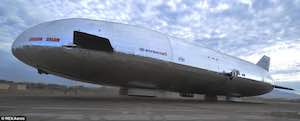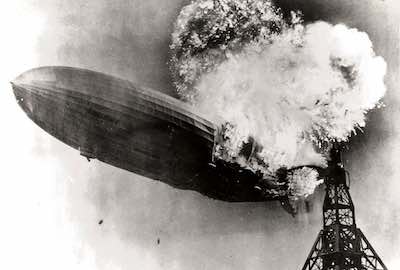New/old zeppelin technology problems: Hydrogen is still as combustible and unsuitable for air-ships. In contrast, helium is still in short supply
Zeppelin-Super-Drones

Drones are in, just ask an armed forces general or other delivery specialist.
Need a 50-ton tank delivered in the middle of the tundra? No problem. Or need a few containers of Christmas ribbons at the North Pole for Santa and his Elves? No problem either.
If you aware of the up and coming things, the latest development should not surprise you: Super-Drones (SDs, my terminology), also known as large blimps or, decades ago, as "Zeppelins."
Zeppelins
Invented by Graf (meaning Count) Zeppelin around 1930, the new technology of trans-oceanic travel was a hit at first sight. You can see that from the many postage stamps then issued in Germany (of course) but also the U.S., Italy, Russia, and others. A small selection shown is below.
Stamps issued by several countries in the early 1930s showing zeppelins.
Clearly, at the time, the "Luftschiff" (German for "air-ship") was widely considered to be a great new technology that would revolutionize long-distance travel and transport.
Indeed, the idea of having a large stream-lined airborne "ship" that could move with little energy between continents was not bad. What could possibly go wrong?

There was just a little problem, namely the need to have that large structure filled with a gas substantially lighter than air, in order to provide the necessary lift to keep the air-ship up there in the sky.
The Problem
The problem was the required amount of such a light gas. There really are only two gases known that could fulfill that needed lift, namely helium and hydrogen. Both are gases that are much lighter than all other main constituents of air (nitrogen at 78%, oxygen at 21%, and argon at 1%).
Helium (being an inert "noble gas") is non-combustible but relatively rare. In contrast, hydrogen, being even lighter than helium, can be produced in large quantities by electrolysis from water and by other methods. The original "Zeppelin"-design called for helium as the gas to fill the structure. However, helium, especially in the quantity required, was rather expensive at the time (and still is to this day). So, needless to say, the much cheaper hydrogen was soon substituted for helium to provide the required lift. In fact, the hydrogen gas provided even more uplift than helium; clearly a win-win situation -- you might think.
However, hydrogen--in contrast to helium--also has another property that eventually led to the whole zeppelin idea's doom. That property is hydrogen's propensity to ignite upon mixture with air at concentrations anywhere between 5% and 95%. Indeed, that is the largest range of ignition of any gas known to exist.
It was just a matter of time when a disaster would occur. A simple small electrical spark (like the ones you experience walking in winter's dry air across your floor and touch anything) would set off a fireball. Exactly that happened with the air-ship
Hindenburg on May 6, 1937, when it docked at the Naval Air Station Lakehurst in Manchester Township, NJ. The whole thing went up in a ball of fire, killing 36 people in the process, and brought an abrupt end to the air-ship era. See pictures nearby.

The Hindenburg in flames; photo:
Wikipedia.
So, the question must be: will the new air-ships or SDs (next picture) be any better?

New age zeppelin,
Thunderbird 2; photo:
Daily Mail.
The Lockheed Martin Corp. has a similar design with their
LMH-1 air-ship.
Helium is Critical
Frankly, I have my doubts about the new/old zeppelin technology, for two simple reasons: Hydrogen is still as combustible as it was a century ago and, therefore, is unsuitable for air-ships. In contrast,
helium is still in short supply. Unfortunately, there is no easy way out of that dilemma. And, once lost to the atmosphere, helium is essentially not recoverable.
However, helium is critically important to run many sophisticated instruments in the fields of chemistry, physics, and medicine. Furthermore, its (natural) isotope "3He" is critical for neutron research but also extremely rare and occurs in nature at only one millionth of the common isotope "4He."
Therefore, instead of wasting this resource on zeppelins and blimps, I surmise that helium would better be reserved for its important medical and technical applications, even if it means that "Santa's Elves may have to wait a bit longer for the material to build the children's toys."
Dr. Klaus L.E. Kaiser -- Bio and
Archives |
Comments
Dr. Klaus L.E. Kaiser is author of CONVENIENT MYTHS, the green revolution – perceptions, politics, and facts Convenient Myths

 Drones are in, just ask an armed forces general or other delivery specialist.
Need a 50-ton tank delivered in the middle of the tundra? No problem. Or need a few containers of Christmas ribbons at the North Pole for Santa and his Elves? No problem either.
If you aware of the up and coming things, the latest development should not surprise you: Super-Drones (SDs, my terminology), also known as large blimps or, decades ago, as "Zeppelins."
Drones are in, just ask an armed forces general or other delivery specialist.
Need a 50-ton tank delivered in the middle of the tundra? No problem. Or need a few containers of Christmas ribbons at the North Pole for Santa and his Elves? No problem either.
If you aware of the up and coming things, the latest development should not surprise you: Super-Drones (SDs, my terminology), also known as large blimps or, decades ago, as "Zeppelins."

